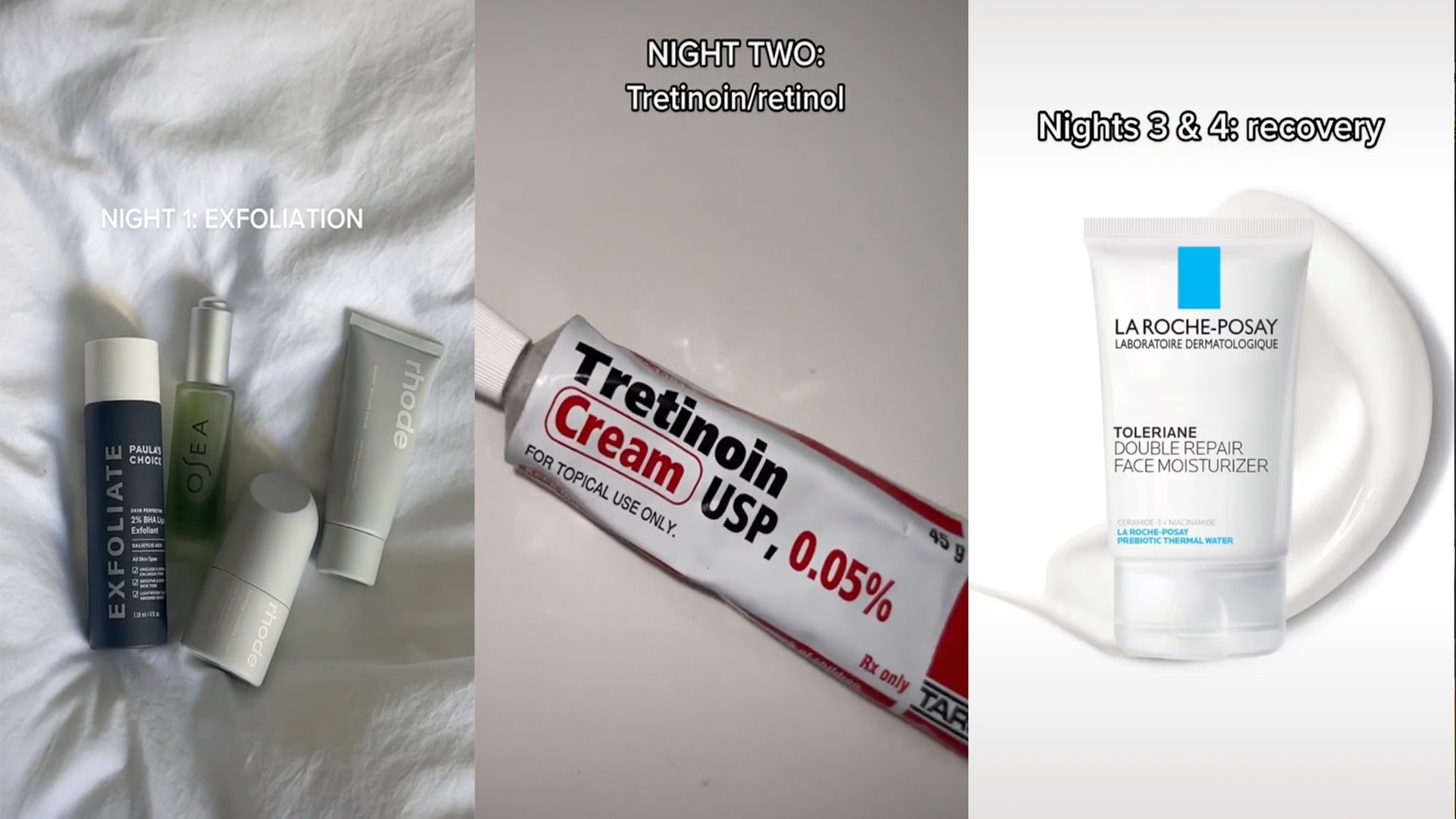
While tons of TikTok beauty trends are largely gimmicky or simply rename existing cultural practices, skin cycling is the brainchild of an actual dermatologist, and it’s helping people understand the way certain products can work for their skin.
The trend comes from Dr. Whitney Bowe, a board-licensed dermatologist and content creator herself — which explains why the more scientific skin approach has taken off on social media. It involves using certain types of products and active ingredients in a prescribed order in order to give the skin a built-in time to both receive treatment and recover from it. The clear timetable for the skincare method has helped beauty enthusiasts understand how often more powerful products should be used on a daily basis, which helps to avoid extreme irritation.
The tag #skincycling has racked up 48.6 million views on TikTok, and Dr. Bowe’s account has over 800,000 followers looking to learn her unique method. The most viral version of skin cycling is currently Dr. Bowe’s four night routine that she recommends for sensitive skin: exfoliate, retinoid, recover, and recover. The routine can be shortened by taking out one night of recovery for less sensitive skin, which may lead to quicker results from the active ingredients on exfoliation and retinoid nights. At the end of the three or four night cycle, you should repeat from the beginning. During the day, you should have a consistent routine that doesn’t change with each of the skin cycle nights.
Dr. Bowe came up with the concept of skin cycling after realizing that many of her patients were over-exfoliating or using harsh products too often. “You can use a nourishing moisturizer twice a day, but when you try to push the workhorses (the acids, the retinoids) you can actually do more harm than good — including damaging the skin barrier, experiencing low-grade chronic inflammation, increasing free radical damage, accelerating the aging process and worsening hyperpigmentation,” said Dr. Bowe to The Well. “I started realizing, as we dove into patients’ actual routines, that we needed to build in recovery days to let the skin repair.”
On each of the prescribed days, users can use any product that accomplishes the goal set forth by the name. Dr. Bowe does recommend certain products that she personally uses or approves of (she has her own brand of products made with the skin cycling routine in mind), but TikTokkers have found plenty of alternatives that work for them.
How to skin cycle: A step-by-step guide
Step 1: Exfoliate
Each step of the skin cycle starts typical skin maintenance, which means cleansing. Use whatever typical cleanser you already have before taking on the goal of night one: exfoliating.
Exfoliating sloughs away dead skin cells on the surface of the skin, making way for moisturizing and retinoid products to work their magic. To achieve this, Dr. Bowe recommends using a chemical exfoliant rather than a physical exfoliant, as the latter tends to be more abrasive.
Chemical exfoliants can use a variety of active ingredients: salicylic acid, lactic acid, glycolic acid, and more. Each type of exfoliant helps achieve a different skin goal, from fighting acne to brightening skin, so choosing the specific exfoliating product is up to each individual.
After using your exfoliating product, layer on a moisturizer as you normally would. This can be any type of moisturizer that helps keep your skin hydrated and that you personally enjoy.
Step 2: Retinoid
Once again, before you slather on your active skincare product, you gotta do the maintenance: Cleanse your skin as usual first! Dr. Bowe also says to make sure the skin is patted fully dry, as damp skin plus retinoids can drive irritation.
Then, night two of the skin cycle is all about continuing to treat the skin. Retinoids are a class of skincare products that use retinoic acid and can be over the counter like retinol and tretinoin, or prescription based. They typically stimulate collagen production and increasing cell turnover, which in turn can help lessen the appearance of wrinkles and treat skin conditions like acne and psoriasis.
After your retinoid product, make sure to continue to apply moisturizer as usual.
Step 3 (and possibly 4): Recover
You know the drill by now: Start this night like any other and cleanse that skin.
Then, after two nights of treating the skin with active ingredients, it’s time to give it time to recover. You can accomplish this with any number of soothing skincare products that you have on hand, but at the very least, this means slathering on your trusty moisturizer. If you’d like, the recovery nights are also when you can work in additional steps like sheet masks or hydrating serums that use gentle, moisture enhancing ingredients like hyaluronic acid, glycerin, or petrolatum.
Repeat your recovery regimen for a second night if you have sensitive skin, then go back to the beginning of the cycle and start with exfoliating on the following night. Dr. Bowe says that any irritation caused by beginning the use of a new exfoliant or retinoid product should clear up by the end of your second skin cycle, and you should start seeing results. For dramatic results, you gotta stick with it even longer — it’s a patient process!
